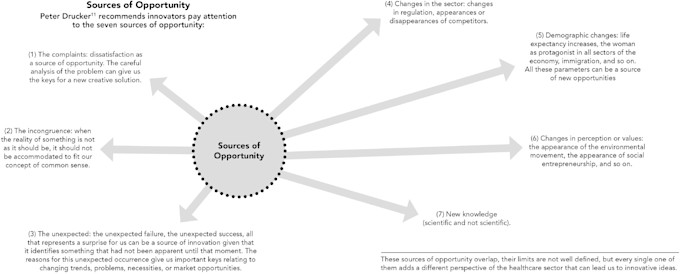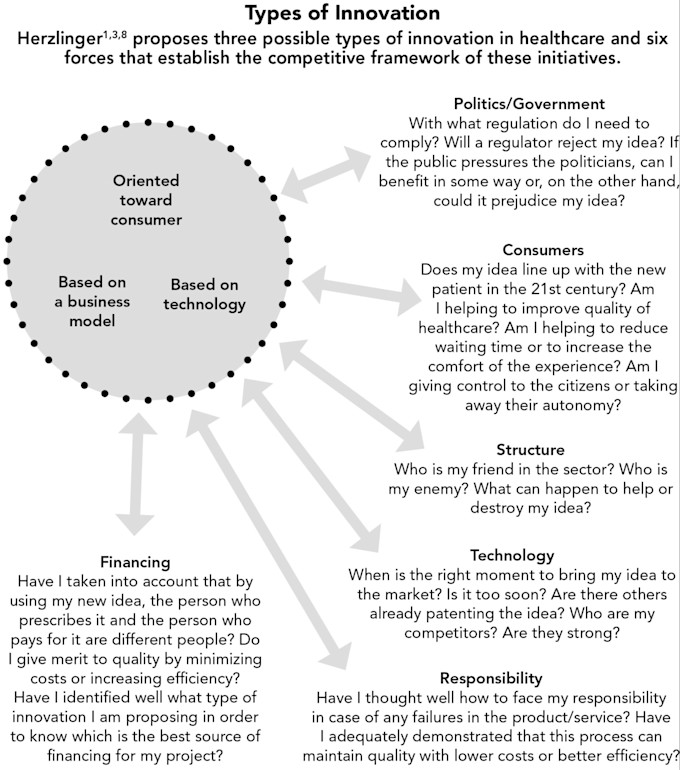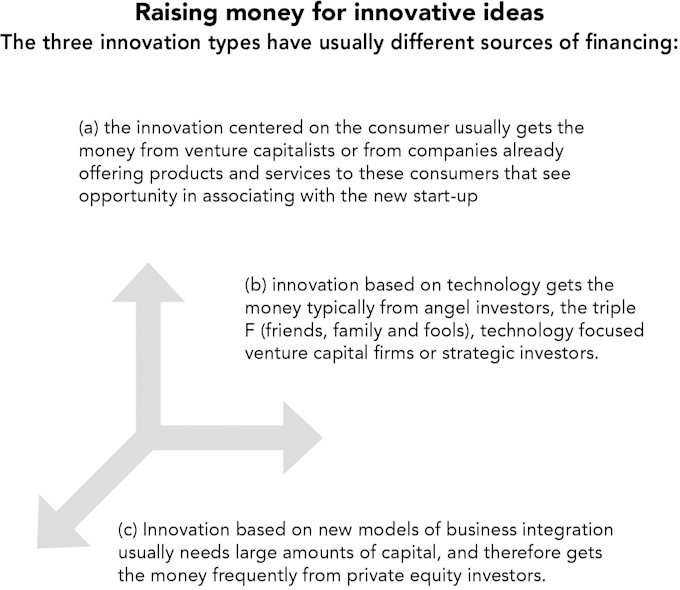How valuable is an idea? To answer this question, we need to know the history of the idea — the process from abstract to reality. Where do ideas come from? What is the difference between a good idea and an opportunity? How does one evaluate an idea’s potential? What are the challenges within the health sector in launching a new idea? How can the healthcare professional capture and generate this value throughout the process and obtain a fair reward for the effort?
I will offer answers to these questions, but it is important to start at the beginning, as the answer establishes the fundamental principle that is the crux of this work: An idea is not worth anything in and of itself; an idea in practice is worth much more.
However, it is important to understand that investors are not investing in ideas but rather in carrying them out. An idea is valuable in and of itself, but what is truly valuable is carrying it out from its abstract setting to the real world.
People are worth more than ideas. Therefore, we will begin by analyzing where these ideas come from and where to look for them, distinguishing between the process of innovation and the process of entrepreneurship.
INNOVATION AND ENTREPRENEURSHIP, ENTREPRENEURSHIP AND INNOVATION
Both concepts are used interchangeably to describe the process of creating something new, ingenious, creative, and valuable. Nevertheless, I believe that they do not mean the same thing.
Innovation is a more intellectual process, more creative, in that it deals with the world of ideas. Entrepreneurship, on the other hand, is a more organizational process that deals with the world of action. To define innovation, we should understand where these ideas come from and distinguish these ideas from opportunities. To describe entrepreneurship, we must understand the process of delivering our ideas to the market. In this context, innovators cannot be entrepreneurs if they create something different and valuable but stop there and only use it in their environment.
For example, a surgeon who adapts or creates an instrument for personal use that subsequently improves patient outcomes is undoubtedly an innovator. But an entrepreneur is always going to the next level. An entrepreneur with an innovation does not stop there; that surgeon tries to bring the innovation to the medical sector, understanding that society will benefit.
It is a question of nuance, and certainly in many realms, innovation is defined as a process that includes the market placement of the product or service. This is, of course, an equally valid definition. The terms are frequently confused because what is certain is that in the real world, the moment when we move from innovation to entrepreneurship is not precise. It is a certain mode on a continuum, two overlapping processes, and two parallel activities. And thus, we see the confusion.
Doctors (and, in general, all healthcare professionals) are privileged to be innovators and entrepreneurs, although we are often not conscious of it. Being on the clinical assistance front lines, we can figure out the clinical needs before anybody else can, even while we carry out our work. Nevertheless, it seems that professionals perceive the process of generating good ideas as complex and difficult. It isn’t easy to have good ideas.
WHERE DO THESE IDEAS COME FROM?
We could define innovation in generic and universal terms, like the process of introducing something new and valuable. From this definition, two obvious and fundamental ideas emerge. Innovation should:
Drive “novelty”; it should be different than before.
Drive merit or value; it should offer something better.
However, we must also bring up another fundamental idea that is not as obvious: where these innovative ideas are found (Figure 1). If we try to improve or create something of value, the three fundamental initiators of innovation cannot be anything other than:
An existing problem — something not yet resolved or that does not work.
Dissatisfaction — something that does work but could function better.
A market opportunity — the perception that by creating something of value, the consumers, the system, other businesses, or society will be open to adopting our idea.

Figure 1. Sources of Opportunity for Innovation
Problems are an excellent source of new ideas. When a professional is “angry” about something, that person will likely come face to face with a good opportunity to improve it. Let’s look at an example.
A pediatrician discovers that the newborns’ incubator temperature is incorrect because the sensor falls off frequently. Taping the sensor on the child’s skin is unsuitable because it produces skin lesions.
An innovative pediatrician in this case would 1) identify the problem, 2) imagine a solution, and 3) plan how and who could implement a solution. In this case, the pediatrician could, for example, contact an engineer, share her idea, and collaborate on designing a new generation of incubators by applying alternate means of taking the child’s temperature.
Dissatisfaction is equally as important to discovering new opportunities. Let’s look at another example.
A radiologist is fed up with watching patients being moved from a stretcher/hospital bed to a radiology table. It works, as it always has, but we lose time and expend great physical effort. The radiologist identifies the problem and imagines a possible solution: a new stretcher designed with a space below the patient where you can introduce the X-ray film.
The radiologist plans who can carry this idea into practice and contacts the hospital bed manufacturer. He patents his idea, designs a prototype, and the idea arrives on the market and spreads to hospitals worldwide.
Finally, the “market opportunities” can also be a source of new ideas. These market opportunities are usually related to opportunities that would reduce costs and, with the appearance of new demands, create products or services that would occupy a niche in a market that was nonexistent up until that point.
For example, let’s suppose an eye doctor realizes the importance of using ophthalmoscopes in Africa to detect eye problems. Still, the high costs make it impossible to extend their use. Is it possible to imagine a less expensive conventional ophthalmoscope? Identifying the problems helps the doctor determine who can help and deliver the initiative to an engineer to design the ophthalmoscope “without a lens,” with a much lower standard cost.
The search for new ideas is, for the most part, an attitude more than a task. It does not deal with looking for new ideas as much as maintaining an attitude of continued skepticism to improve our environment. The success stories in the healthcare profession rise from one or the other of these three initiatives (problem, dissatisfaction, and market opportunity) or, on occasion, from the combination of all three.
For this reason, healthcare professionals 1) must learn to perceive the problems and unhappiness, and 2) know who is needed to make the idea happen. Hospitals and health clinics should promote this constant search for innovative ideas, being conscious that the future of our competitiveness in the health sector depends on these ideas.
A final point before beginning to analyze the opportunities for innovation in the health sector: I have noted on many occasions that we are all the same when it comes to putting up a wall in front of innovation, thinking that as doctors, we do not have the necessary knowledge to become entrepreneurs with our ideas.
We often forget that innovation and entrepreneurship are team efforts. Once an opportunity is detected, we know we are privileged to pursue it. It is important to understand our limitations and surround ourselves with skilled people.
OPPORTUNITIES FOR INNOVATION IN HEALTH
The healthcare sector presents great opportunities for start-ups. It is certain that the double social and personal benefits (on one hand, to improve society as a whole, and on the other, to obtain a fair compensation for our efforts) will convert healthcare into an especially gratifying sector in this sense.(1,2)
Worldwide, people aspire to have better quality healthcare with universal access. Given the higher health costs, many thousands of millions do not have more than just the basic products and services. This includes countries with quality healthcare systems, like those countries in our realm, where healthcare is not offered equally for all. The system user (public or private) often complains about its efficiency. The costs are going to rise, and so are consumers’ expectations, and all will affect the government, the businesses that provide health services, and all individual users who pay for that service.
Despite the magnitude of the opportunity, healthcare moves billions of dollars per year throughout the world. The system’s needs are important, and the innovations are trying to open up a path in the sector that has failed miserably. Why? The failures are usually blamed on a lack of knowledge of how healthcare start-up projects align with the forces moving the healthcare sector.
Many reference points exist to orient the innovation and its impact on healthcare. I offer reference points that are especially useful for understanding innovation in healthcare:
Innovation aimed at the consumer.
Innovation based on technology.
Integrated innovation.
Furthermore, the six forces that affect all the new business models in the healthcare sector are:
Financing
Structure
Policies and government
Consumers
Technology
Social responsibility
This point follows the leading school of thought by Regina Herzlinger(3-5) at Harvard University and allows a better understanding of how to innovate in our sector.
TYPES OF INNOVATION
We will first see three types of innovation in the health sector (Figure 2). This is important, as each type of innovation will forge a different path toward success and will, for the most part, need a different strategy.

Figure 2. Types of Innovation
On frequent occasions, our idea may be classified in more than one category. Despite this, the innovator/entrepreneur will need to try to identify the fundamental type of innovation in which the idea will be competing. One and only one must be identified because each of them will interact differently with the six forces we will discuss later. This will also allow us to establish the ideal reference point to understand how to focus the idea and analyze it to see if it is just a good idea, or indeed, an opportunity.
1. Innovation Centered on the Consumer
This type of innovation is directed squarely at the consumer and tries to change the experience of the healthcare user by developing new relationships with the system, improving the quality of received attention, and/or reducing the costs of the service.
In the future, healthcare will be centered on the patient, and patients will want to be in control of their health. This tendency is likely to affect all sectors of the economy, but the empowerment that we refer to is especially intense in healthcare, where service providers are frequently fragmented, leaving the responsibility of managing their own healthcare in the hands of consumers.
A good example of this type of innovation is a portable screening device that measures the sugar levels of diabetic patients and would improve their monitoring throughout the day. Since diabetes is an illness that needs frequent control and personal care on the part of the patient, by providing a more active monitor, the health systems and entrepreneurs hope to include the patient in this new type of relationship. Patients will improve their results and will minimize healthcare costs (for example, having fewer complications associated with the illness based on fewer hospital stays).
Patients with chronic illnesses have a special need for this type of innovation, given that today, they frequently have to find the specific providers, specialists, centers, medicines, medical records, and so on. They need to coordinate the attention they receive. Nobody coordinates this attention for themselves. Given that they usually are older patients and it is a complex task, they might make errors that minimize the quality of the attention they receive.
Innovations of this type can also be steered, for example, to reduce the time patients spend going from one health center to another, by offering hospitals “vertical care.” (We define this as the way specialized hospitals in all areas deal with the same illness.) These new centers allow us to deal with the patient by offering comfort and efficiency without needing to send the patient to different places. These centers are aware of the patients’ perspective, and they design their care process and methods to make patients’ lives more comfortable.
Does another profession have the concept of a “waiting room ” in its realm? Innovative initiatives that try to reduce or even eliminate the perception of waiting also represent centralized innovations for the consumer. For example, the past few years have seen a surge in walk-in centers that offer immediate attention and are slowly gaining the patients’ trust in countries all over the world.
2. Innovation Based on Technology
All innovations pertaining to this group are more likely to be diagnostic kits, drugs, medical devices, new forms of therapy, and so on, that strengthen the scientific and technological advances.
If a healthcare professional designs and patents a new antibiotic for the surface of intravenous catheters to reduce infections, we can say that this professional has developed a technology-based innovation. Designing and patenting a new knee prosthesis is also a technology/scientific innovation.
Also belonging to this group is the subtype of innovative technology based on initiatives using information technology. Our actions depend, in great measure, on the information that is available to us. In healthcare, information is vital and usually located in many places. Innovations that connect these “islands of information” are fundamental to reducing costs, improving quality, and reducing medical errors, among many other advantages.
3. Innovation Based on New Models of Business Integration
These initiatives are those that a priori are furthest from the healthcare professionals. This type of innovation is based on consolidation, in adding different participants to healthcare to make them bigger and, in theory, more efficient and profitable.
Healthcare is very fragmented; we are naturally very individualistic as healthcare professionals. Many doctors work in private health practices or offices with fewer than three people. So many health centers depend on themselves (they do not form a chain). The sector that makes medical supplies or machinery is equally fragmented, and is composed of thousands of small companies.
To unite these many diverse initiatives, we can achieve what is known as the economy of scale: bringing together small companies to form larger ones that will have, for example, more negotiating strength. That way, providers that do not want to lose an important client will adjust their maximum prices. Or, we can eliminate the repeated charges for the same service that, now that we are working together, are not necessary (Figure 3).

Figure 3. Sources of Financing for Innovation
There are two types of integration:
Horizontal integration: dealing, for example, with integrating 10 private hospitals into one chain of hospitals that operate under the same trademark, in such a way that they can provide better service at lower costs.
Vertical integration: dealing, for example, with integrating all the necessary services for the treatment of one illness in only one clinic, which ultimately offers better service to the patient and therefore, improves the quality, raises the efficiency, and minimizes the cost. An example would be the emerging centers from the past few years that deal with neurologically injured patients that include very different disciplines such as trauma, rehabilitation, psychology, sexual dysfunctions, and so on, to give the patient coordinated care.
The value of an idea in the healthcare sector is realized not in its conception but in its execution. True innovation bridges the gap between theory and practice, transforming abstract concepts into tangible solutions that address real-world problems. By distinguishing between innovation and entrepreneurship, healthcare professionals can better navigate the path from ideation to market entry. By identifying unmet needs, dissatisfaction, or market opportunities, healthcare professionals can collaborate with skilled teams to bring their ideas to fruition. Whether through consumer-centered innovations, technological advancements, or new business models, the goal is to enhance patient care, improve efficiency, and reduce costs. Encouraging a culture of continuous improvement is essential for significant advancements in the healthcare sector.
Excerpted from Innovation and Entrepreneurship in the Healthcare Sector: From Idea to Funding to Launch by Luis G. Pareras, MD, PhD.
REFERENCES
Burns LR. The Business of Health Care Innovation. Cambridge University Press;2005: 398.
Pisano GP. Science Business: The Promise, the Reality, and Future of Biotech. Harvard Business School Press; 2006: 237.
Herzlinger RE. Innovating in Health Care — A Framework. Harvard Business School Background Note 314-017. July 2013 (Revised July 2015).
Herzlinger RE. Consumer-Driven Health Care: Implications for Providers, Payers and Policy-Makers. Jossey-Bass;2004: 978.
Herzlinger RE. The New Health Care Venture Evaluation Process. Harvard Business School. 9-304-003;2003.

